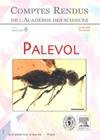安纳托利亚最东部始新世晚期Süngülü哺乳动物群的增补以及巴尔干托利亚周边地区始新世-更新世过渡时期的情况
IF 1.3
4区 地球科学
Q3 PALEONTOLOGY
引用次数: 1
摘要
始新世-更新世过渡时期标志着一个与哺乳动物群明显变化相关的全球气候剧变时期。化石证据对于研究分类群在不同时期的分布以及确定非生物参数如何影响古代生物多样性是不可或缺的。在这里,我们报告了产自东安纳托利亚苏恩居鲁(Süngülü)的反刍半齿兽和一种新的拟人灵长类动物。发现了三个反刍动物类群,分别是Iberomeryx parvus Gabunia(1964年),Iberomeryx Gabunia(1964年)的一个较大的物种,以及Bachitheriid(与Bachitherium sp.同属)。Sungulusimias unayae n. gen., n. sp.的下臼齿的特征是原齿和元齿间隔很近,高度和体积相似,副齿骤尖,几乎与元齿合生,中颊齿较强,内齿通过后嵴与下齿没有很强的联系。该动物群与啮齿类动物群的组成表明,Süngülü的年代可能为晚始新世晚期,但也不能完全排除早渐新世的可能性。来自 Süngülü 的啮齿动物群表明,巴尔干托利亚周边地区的地方性一直持续到晚始新世,而东安纳托利亚则位于东亚、印巴和欧洲之间动物交流的战略通道上。在始新世-更新世过渡期间,巴尔干亚托利亚可能起到了 "收容所 "的作用,各种类群在这里被收容了相当长的一段时间,然后才开始在大飓风时期向西欧殖民。本文章由计算机程序翻译,如有差异,请以英文原文为准。
Additions to the late Eocene Süngülü mammal fauna in Easternmost Anatolia and the Eocene-Oligocene transition at the periphery of Balkanatolia
The Eocene-Oligocene transition marks a period of dramatic global climatic change correlated with pronounced mammalian faunal change. Fossil evidence is indispensable for studying the distribution of taxa through time, and determining how abiotic parameters shaped ancient biodiversity. Here we report ruminant artiodactyls and a new anthropoid primate from Süngülü, a locality in Eastern Anatolia that has yielded a diversified and largely endemic assemblage of rodents. Three taxa of ruminants are recognized, the tragulid Iberomeryx parvus Gabunia, 1964, a larger species of Iberomeryx Gabunia, 1964, and a bachitheriid referred to cf. Bachitherium sp. A lower molar is identified as the new eosimiid primate Sungulusimias unayae n. gen., n. sp., which is the first occurrence of Paleogene anthropoids in western Asia. The lower molar of Sungulusimias unayae n. gen., n. sp. is characterized by protoconid and metaconid closely spaced and of similar height and volume, paraconid cuspidate and nearly connate with metaconid, strong mesiobuccal cingulid, and entoconid without strong connection to hypoconulid via the postcristid. The composition of this assemblage together with rodents indicates a probable Latest Eocene age for Süngülü, although an early Oligocene age cannot be completely ruled out. The rodent fauna from Süngülü suggests that endemism persisted at the periphery of Balkanatolia until the latest Eocene while Eastern Anatolia was situated in a strategic corridor for faunal exchanges between eastern Asia, Indo-Pakistan and Europe. During the Eocene-Oligocene transition, Balkanatolia probably functioned as a “holding pen” where various taxa were confined for significant intervals of time before proceeding to colonize Western Europe at the Grande Coupure.
求助全文
通过发布文献求助,成功后即可免费获取论文全文。
去求助
来源期刊

Comptes Rendus Palevol
地学-古生物学
CiteScore
2.10
自引率
0.00%
发文量
39
审稿时长
17.6 weeks
期刊介绍:
Comptes Rendus Palevol is a fully electronic and peer-reviewed journal, with a continuous publication stream, devoted to palaeontology, prehistory and evolutionary sciences. It publishes original research results, in French or English, in the following domains: systematic and human palaeontology, prehistory, evolutionary biology and macroevolution, and history of sciences. Thematic issues may also be published under the responsibility of a guest editor. All articles published in Comptes Rendus Palevol are compliant with the different nomenclatural codes. A copyright assignment will be signed by the authors before publication.
 求助内容:
求助内容: 应助结果提醒方式:
应助结果提醒方式:


